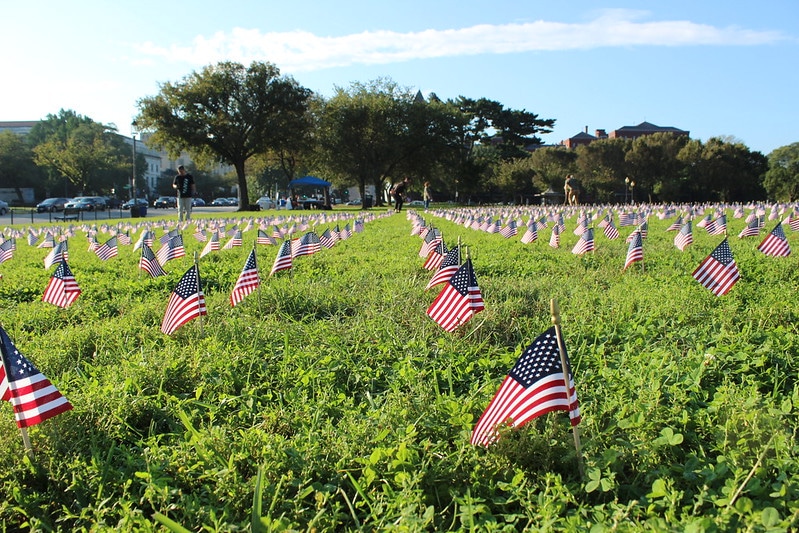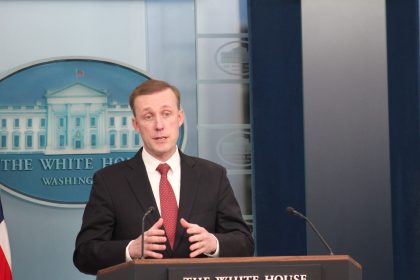Changing Military Fuels IAVA Fight for New Veterans’ Needs
PARTNER CONTENT

WASHINGTON – It used to be that veterans’ organizations were simply part of the landscape of small-town America.
You might cross the threshold of an American Legion or VFW hall as a child – somehow most likely in connection with a Little League award night or a confirmation party – but they were mostly places set aside for men to gather and socialize with those who shared their unique experience.
They were, in my youth anyway, a generation that had gone to war, but didn’t necessarily want to talk about it, a generation whose post-military lives were transformed by the GI Bill, and who were part of the fabric of the community, fathers and grandfathers, stars mainly of the Veterans and Memorial Day parades.
Today, like much else in the world, the veterans’ organization has been transformed. This generation’s veterans aren’t so much interested in having a physical, brick and mortar place to go to, but instead want aid and services and advocacy generations past never would have dreamed would be available to them.
The undisputed leader in this new vanguard of veterans’ groups is the Iraq and Afghanistan Veterans Association, a nonprofit 501(c)(3) that now has more than 425,000 members.
Founded by Iraq War veteran Paul Rieckhoff in 2004, the New York City-based organization’s mission is to unite, empower and connect post-9/11 veterans through education, advocacy and community.
Its programs include non-partisan advocacy on Capitol Hill, data-driven research on post-9/11 veteran issues, veterans transition assistance through its Quick Reaction Force program, and community building through its VetTogether and online community events.
Earlier this week, The Well News caught up with Sean Ullman, IAVA’s chief operations and revenue officer, to find out about the organization’s latest successes and its priorities going forward.
Ullman, who joined the organization in January 2017, has an extensive background in executive leadership, having served in leadership roles with the American Red Cross, Habitat for Humanity International, and New York University.
TWN: As I prepared for this conversation, I couldn’t help but be struck by how the world has changed, over my lifetime, in terms of the concept of veterans’ affairs. Assuming you share that perspective, why do you think that’s happened?
Ullman: I think there are a couple of reasons for that, and, of course, we have to acknowledge, we’re talking in generalities here.
One thing that’s changed, I think is the mindset of veterans and society as a whole. Looking back to the past, and particularly to the Greatest Generation, I think the mindset was you started out a civilian, you did your tour of duty, and you tried to reintegrate yourself as quickly as possible into civilian life.
One of the differences between then and now is today we’re talking about a much smaller population – the less than 4 million people who have served since 9/11 — than we were after say, World War II.
And we’re also talking about a generation for which, for the first time, the military is a career for a lot of folks. The number of deployments has gone up exponentially, from one or maybe two, to seven or eight. So, it’s a very different mindset.
The other thing that’s different is the investment in how this community is perceived and how it’s helped is now much more substantial. In a sense, there’s a lot more investment in a smaller group of folks. Which is good. At the same time, we’re living in a time when fewer people have a family member that served, and so there’s probably less of an understanding of the needs of the community.
TWN: How does this impact something like fundraising? Is the fundraising you’re doing now comparable to what you did in the past with other organizations?
Ullman: Fundraising is hard. No matter where you do it. Fundraising in an organization like this is different because it’s not “programmatic,” by which I mean, you’re not giving money to fund a specific program. Instead, you’re asking people to fund advocacy, which is what I like to call the steady drum beat that gathers support and imparts change. So, it’s less tangible in a way. And it is why so few advocacy organizations exist in this space.
If I can go back to the changes you referenced earlier, a lot of the organizations that existed for veterans in the past were membership organizations. We are not. We don’t charge dues to our members. We believe that they paid their dues by serving this country. Because we don’t have our members paying to keep our lights on, we have to reach out to others for support. And fortunately, we’ve been good at it. Now, we might not be as big as others in our space, like the Wounded Warrior Project, but we’re getting our work done and having huge success.
TWN: I’m most familiar with your advocacy work, but there’s more to IAVA than that, isn’t there?
Ullman: There is, and I think it’s a part of the organization that gets overlooked. This is the direct services that we offer to veterans in need through our Quick Reaction Force (QRF) program.
QRF is available to any veteran or family member, regardless of era, discharge status or location and we provide 24/7 peer support, comprehensive care management and connections to quality resources. QRF can be reached through the website quickreactionforce.org or by calling 855-91RAPID (855-917-2743).
Through this service veterans can talk to a fellow veteran today, no matter what their challenge is, and we will walk them through it. It’s probably what we focus on most today and it is life changing.
TWN: Did IAVA set out to offer this service?
Ullman: Not initially. Though it was a natural extension of our advocacy work. We were doing our annual membership survey to assess our members’ needs through that and we were doing our advocacy for veterans across the board. We were getting better known through that work, and along the way, people started reaching out to us. They’d say, “I’m trying to get help from the VA, I don’t know where to go” or “I need help navigating my GI Bill benefits, can you help me?” And it happened so frequently that we realized there was a programmatic need for it.
I mean, we’re talking about people calling with everything from concerns about housing related issues to individuals contemplating suicide. Initially, we worked to put people in touch with community and national organizations that were designed to meet the specific need they had. And it has grown tremendously ever since.
TWN: On the advocacy front, probably the thing I’m most aware of is your work to end the use of burn pits in war zones and to get medical assistance for veterans suffering illnesses, like cancer, from burn pit exposure. Where do things stand now in that regard?
Ullman: Well, we had a couple of pieces of legislation introduced in the last Congress that we’re hoping will be quickly reintroduced in this Congress because we had the votes, they just never got to the Senate floor.
Fortunately, we’ve made progress on this issue over four presidential administrations, and we believe we have an ally in President Biden, who has said he believes his son Beau was a victim of burn pit exposure.
Of course, right now, with COVID and everything that entails, we understand the new administration is somewhat focused on other issues. But we’re hoping that within the next few months, once COVID is tackled, there will be some consensus around the view that this has to be dealt with.
TWN: In what way?
Ullman: Well, first to come to an agreement that burn pits should never be used again. And second, the VA needs to accept that exposure to burn pits is a universal element behind veteran health issues, and we need to acknowledge this and improve the delivery of care. I’m optimistic there are public officials who will agree with us on this.
TWN: All right. Another issue IAVA has been very outspoken about is the need to improve services for women veterans. What is the latest on that front?
Ullman: We’re in a unique position, right? Women did not frequently serve in active combat roles until recently. And there’s a lot of trauma that goes into active deployment and into being on the front lines. Both for males and females. So, as a veteran organization, we’re unique in that we can say 11% of our members are female combat veterans.
We’re also in the position of being able to recognize that the needs of male and female veterans are different enough that they need to be advocated for in their own right. For instance, no female veteran should ever be fitted with a male prosthetic; a gynecological appointment is something the VA should offer or there should be a better plan for directing our members to services in their communities to get the care they need for their body. Now that’s just one example.
But for instance, there was a time when women didn’t have access to restrooms in the VA, because there were no women’s restrooms in these facilities. We also have had people reach out to us and say, “I’m tired of going into the VA and having them thank my husband for his service when I’m the veteran.” Basically, what we’re advocating for is an increased recognition of human rights for our female veterans. We’ve had some recent wins, including the Deborah Sampson Act (DSA) getting signed into law earlier this year. This groundbreaking legislation, and the cornerstone of IAVA’s “She Who Borne the Battle” campaign, will significantly reduce barriers to care for women veterans while also expanding services to address issues like reintegrations, homelessness and newborn care. This is a great first step and there’s still much more to be done to effectively support and recognize the service of women veterans.
TWN: Which brings us to another area – modernizing the VA.
Ullman: Modernization is a two-fold proposition. On the one hand, it’s about changing attitudes, and encouraging the thought processes that go into modernization. On the other, we’re talking about taking advantage of 21st Century technology. For example, digitizing records so that every veteran who opts to go to a local doctor can have access to his records without having to go to the VA. Just get things off paper and into a computer. That would seem like a basic core competency. Right now, however, that doesn’t exist, though they are working toward it.
We believe every veteran should have consistent quality of care, regardless of who is seeing them.
TWN: I’m looking down the list here and see … alternative therapies. What are you talking about?
Ullman: I’m actually really big into this issue right now, and what I’m mainly talking to people about is medical marijuana. Because of the war on drugs, marijuana is a Schedule One narcotic. That means traveling with marijuana or having marijuana paraphernalia on you when traveling between states is a very big, go to jail, crime. That’s one aspect of it.
The other issue is the number of states – I think 27 as we speak – that have made some degree of recreational or medical marijuana legal. However, as long as the federal government classifies it as an illicit drug, your VA doctor can’t really discuss how you might be using marijuana as an alternative to traditional care. And, of course, prescribing it for you is out of the question. And that’s a real challenge point.
What we want is to make sure the VA does what the VA does best and that’s researching alternatives to care that will help the veteran population as a whole, and ultimately everybody.
And, specifically, what we want is to get them to start a dialogue about researching whether or not THC, the active component in marijuana, actually has a long-term, sustainable benefit for our population. And that’s just one example.
Another example is the VA’s attitude toward smoking. The standard policy at the VA is that the only path forward for veterans – a group that smokes at three times the rate of nonveterans – is to stop smoking. Basically, “quit smoking to get care” is the mantra.
But there are alternatives to combustible cigarettes that exist today, including FDA reviewed products, that, while not as good as cessation, are better than continuing to smoke. So, we’re advocating for the VA to continue cessation efforts while also recognizing the potential harm reduction alternatives may have for veterans who would otherwise continue to smoke traditional cigarettes.
TWN: The GI Bill is another of your big advocacy areas and this is something that does go back generations. I know many returning veterans from WW II, Korea and so on have said having access to the GI Bill for education when they got out transformed their lives. What’s the status of the GI Bill today?
Ullman: What many people don’t realize is that the GI Bill law actually expired back in the early-to-mid-2000s. So, it just wasn’t available. And we fought hard, alongside other veterans’ organizations, to have it reinstated.
Our argument was that we needed to reinstate the GI Bill as a way to help with recruitment. I mean, the reality is, when we recruit somebody into the military, we have to make sure there’s a benefit that allows them to transition back into civilian life wholeheartedly and meaningfully.
So, we got them to reinstate the law and it was like “Great, we have a new GI Bill.” But then it kind of spiraled from there because all of a sudden, these for-profit educational institutions, which did not exist when the old GI Bill was in effect, start disproportionately trying to engage veterans and get them to use their GI Bill resources in for-profit schools. So for-profit schools then became a big challenge in this space.
The other thing we realized is that there was a need to be able to use GI Bill funds to support enrollment in vocational programs. Because if you’re an engineer in the military, and you can’t transfer that experience into a good-paying engineering job in civilian life, then you didn’t really gain much from your military experience. So now we’re advocating for that.
These are big shifts, but they are slow moving. And they occur against a backdrop in which the GI Bill is essentially on the congressional chopping block every single year.
TWN: One thing I moved from the very top of your list to the end of mine, because of its seriousness, is the topic of veteran suicide. I know IAVA has been extremely active in trying to address this issue. Tell me what you’re doing?
Ullman: Everything we can. I mean, we started with the Quick Reaction Force, which I mentioned earlier, and offering direct services to the veterans that need it. That’s number one. And then we realized that stigma reduction is a vital part of this.
We lose 20 veterans and servicemembers a day to suicide – across all generations of veterans, and that’s unacceptable. To address that, we need people to recognize that mental health is something that needs to be further discussed and that there should be no stigma attached to doing so.
An important aspect of this is advocating that people talk to their family and friends about this topic. At the same time, we want veterans to know we’ve worked very hard to establish a three digit veteran crisis line, which makes 988 the 911-equivalent for any veteran in crisis.
And last year we worked alongside legislators to pass the bipartisan Commander John Scott Hannon Mental Health Care Improvement Act, the most comprehensive veteran suicide bill passed to date which includes critical reforms in how America combats the veteran suicide crisis. Of the 20 veterans and servicemembers that die by suicide every day, 14 are not under the care of the Department of Veterans Affairs (VA). Key provisions of this legislation include the creation of a community grant program within the VA to enhance VA outreach at the local level to help identify isolated veterans and provide mental health services. It also establishes and expands partnerships with organizations around the country to deliver increased telehealth availability. We look forward to working with Congress and the Administration to ensure that this groundbreaking legislation is fully implemented.
And we’re of course still looking for other ways to reach into the community and enable people to have access to mental health care and critical services and support so we don’t have this continued tragic loss within our communities.
TWN: I guess the natural question to wrap this up is, what can our readers do to help you?
Ullman: Well, IAVA has members who run the gamut from people who served, to people who care about serving – veterans and civilians alike. We can’t get this work done and help this population without civilians partnering with veterans to ensure it gets done.
So, the first thing I would say is go to IAVA.org. Join us and see the kinds of things this community is talking about, and then once you are ready and feel comfortable, contact your elected Member of Congress to let them know about the issues they should be thinking about. Ask them to consider inviting IAVA to their next important veterans services meeting because we are the next generation of veterans and want to make sure that that we are helping in any way, shape or form we can. And if they have any inclination to support our group and in partnering with us and making our voice much louder, we will happily accept their contribution to support our mission.
This article was produced in partnership with the Iraq and Afghanistan Veterans of America.

























